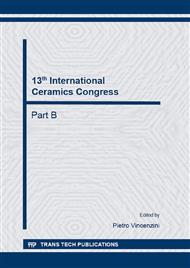[1]
Z.J. Lin, L. Wang, J.Z. Zhang, H.K. Mao, Y.Z. Zhao, Nanocrystalline Tungsten Carbide: As incompressible as Diamond, Appl. Phys. Lett. 95 (2009) 211906, 3pp.
Google Scholar
[2]
Y. Wang, S.Q. Song, P.K. Shen, C.X. Guo, C.M. Li, Nanochain- Structured Mesoporous Tungsten Carbide and Its Superior Electrocatalisis, J. Mater. Chem. 19 (2009) 6149-6153.
DOI: 10.1039/b902744k
Google Scholar
[3]
A. Kumar, K. Singh, O.R. Pandey, Redaction of WO3 to Nano-WC by Termo-Chemical Reaction Rout, Physica E. 41 (2009) 677-684.
DOI: 10.1016/j.physe.2008.11.016
Google Scholar
[4]
R. Koc, S.K. Kodambaka, Tungsten carbid (WC) synthesis from novel precursors, J. Eur. Ceram. Soc. 20 (2000) 1859-1869.
DOI: 10.1016/s0955-2219(00)00038-8
Google Scholar
[5]
C.L. Briant, Tungsten: Properties, Processing, and Applications, in Advanced Materials and Processes 154 (1998) 29.
Google Scholar
[6]
A. Bose, H. Coque, J. Langford, Development and Properties of New Tungsten- Based Composites for Penetrators, J. Pow. Metall. 28 (1992) 383.
Google Scholar
[7]
T.G. Ryu, H.Y. Sohn, K.S. Hwang, Z.Z.G. Fang, Plasma Synthesis of Tungsten Carbide Nanopowder from Ammonium Paratungstate, J. Amer. Cheram. Sos. 92 (2009) 655-660.
DOI: 10.1111/j.1551-2916.2009.02961.x
Google Scholar
[8]
K. Essaki, E.J. Rees, G.T. Burstein, Synthesis of Nanoparticulate Tungsten Carbide Under Microwave Irradiation, J. Amer. Ceram. Sos. 93 (2010) 692-695.
DOI: 10.1111/j.1551-2916.2009.03462.x
Google Scholar
[9]
S.R. Vallance, S. Kingman, D.H. Gregory, Ultrarapid Materials Processing: Synthesis of Tungsten Carbide on Subminute Timescales, Adv. Mater. 19 (2007) 138-142.
DOI: 10.1002/adma.200601129
Google Scholar
[10]
I.V. Nikolaenko, A.P. Shtin, G.P. Shveikin, Preparation of titanium and zirconium oxides by microwave radiation interaction with their hydroxides, Chernogolovka, Institute of Problem of Chemical Physics, RAS (2007) 87-89 (in Russian).
Google Scholar
[11]
G.P. Shveikin, I.V. Nikolaenko, A method for production of transition metal oxide of ultra-nanopowder or a mixture of transition metals oxides, Patent 2, 337, 791 С2 (2008) (in Russian).
Google Scholar
[12]
E.V. Polyakov, L.G. Maksimova, V.N. Krasilnikov, V.A. Zhilyaev, T.A. Timoshuk, O.N. Ermakova, G.P. Shveikin, I.V. Nikolaenko, Thermally stimulated conversion of micellar structure of tungsten glycolate in to nanosized tungsten carbide, Doklady Academii Nauk 434 (2010).
DOI: 10.1134/s0012501610090022
Google Scholar


